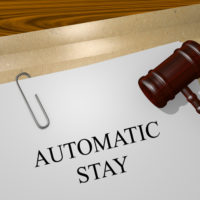The Automatic Stay, Explained

One of the most valuable protections afforded to a debtor filing for bankruptcy is the temporary protection from any collection actions known as the automatic stay. Read on to learn more about how the automatic stay functions and what the stay can and cannot do to protect you from financial harm.
Automatic stay basics
As implied by the name, you don’t have to make a request to receive a stay during your bankruptcy case; the automatic stay enters into effect as soon as you file your petition for bankruptcy. The stay will prevent your creditors from taking any actions to try and collect a debt that existed prior to you filing for bankruptcy. This can include stopping all calls and letters regarding the debt, and stopping debt collectors from garnishing your wages. It can also: put lawsuits on hold when those cases were filed to collect on a debt; prevent a creditor from filing a judgment lien on a piece of property you own; and stop a creditor from repossessing your property. The stay lasts until you receive a discharge of your debts through bankruptcy. At that point, creditors will be barred permanently from contacting you regarding any debts that were discharged in bankruptcy but will be able to resume trying to collect debts which were not discharged. For example, if you became behind on car payments prior to bankruptcy but chose to keep the car, you will need to become current on payments in order to stave off repossession of the car after the stay is no longer in effect.
What sorts of collections won’t the automatic stay prevent?
Collection of certain forms of debt and certain court proceedings are unaffected by the stay. These include child support and alimony arrears, actions for modifications of child support, tax audits or assessments, criminal proceedings, or attempts to collect debts that aren’t part of the bankruptcy estate. If you incurred debt after filing for bankruptcy, for example, this will not be considered part of the bankruptcy estate, and creditors can take steps to collect that debt.
If you have recently filed for bankruptcy or had a bankruptcy filing dismissed in the past year, you may not be able to receive all the protections of the stay upon subsequent filings. Additionally, there are limited circumstances under which a creditor may receive relief from the stay, which allows that creditor to continue to try to collect a debt during your bankruptcy case. A skilled bankruptcy attorney can help you prevent creditors from receiving relief from a stay, to allow you time to recover financially and create a plan to move forward after filing for bankruptcy.
If you are facing mounting consumer debt and need professional assistance in negotiating a workable payment plan or filing for bankruptcy in California, contact the dedicated and knowledgeable Ventura consumer law and bankruptcy attorneys at Rounds & Sutter for a consultation, at 805-650-7100.
